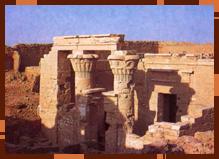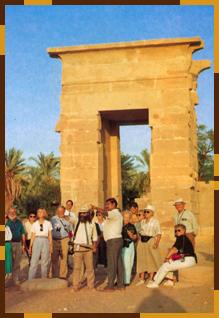Oases
| Kharga
- The Chain of Roman Fortresses |
All
the oases have always been crossroads of caravan routes converging
from the barren desert. In the case of Kharga, this is made
particularly evident by the presence of a chain of fortresses
that the Romans built to protect the Darb el-Arbain, the long
caravan route running north-south between Middle Egypt and
the Sudan. The forts vary for size and function, some being
just small outposts, some guarding large settlements complete
with cultivations. Some were installed where earlier settlements
already existed, while others were probably founded anew.
All of them are made of mud bricks, but some also contain
small stone temples with inscribed walls. So far, many of
these sites have suffered relatively little damage, still
looking like frozen images of what life must have once been.
 |
The
majority of these fortresses lie close to the main road which
crosses the oasis north to south (following the ancient track
of the Darb el-Arbain) and are in fact visible on both sides
of it. Arriving from north, if the wind is not blowing too
much sand, the two small forts of Qasr el-Gyb and Qasr el-Sumeria
can be seen on the left. Access is by 4x4 only. A few kilometres
south, lies 'Ayn Lebekha, which may be reached by a normal
vehicle as well, even if the last part of the road is not
paved. Here there is a temple, a small fort at a certain distance,
and a group of decorated tombs. The land must have been once
irrigated by a subterranean aqueduct which has recently been
reused by local farmers to start a cultivation north-east
of the temple.
One
of the most impressive fortresses of the whole area is el-Deir,
a huge enclosure with twelve round towers which lies east
of the old Darb el-Arbain. The site is definitely worth a
visit, but a 4x4 is strongly suggested. There is a well-marked
track up to a certain point, but a chain of dunes has cancelled
the last couple of kilometres and one must seek alternative
access south of them. Immersed in the beautiful landscape
immediately east of the main road, is the famous prison of
Kharga. Do not attempt to approach it.
The
easily accessible forts of Nadura, Qasr el-Ghueita and Qasr
el-Zayyan are situated close to the main road on the top of
high hills which allowed a strategic control of the territory.
All contain small stone temples, the first Roman, the second
Persian and the third Ptolemaic. The most amazing fortress
of the area is probably Dush, at the southern edge of the
oasis. A huge complex contained two stone temples, a monumental
gateway built by Trajan, and evidence of an elaborated subterranean
water system. The beautiful landscape and impressive setting
are not to be missed.
Two
other Roman settlements must be mentioned, although quite
difficult to reach. One is 'Ayn Amur, a little spring halfway
between Kharga and Dakhla along the caravan route which bears
the same name. Here a small stone temple with a large mudbrick
enclosure were built around the spring.
|

|
The
other is Umm el-Dabadib, a large settlement guarded by a small
but impressive fort and once supported by an extensive cultivation,
which lies along the Darb 'Ayn Amur in an area today completely
isolated. Both sites may be reached by 4x4, but especially
'Ayn Amur requires quite expert drivers. It is worth repeating
that all these isolated sites must be visited with the permission
of the local Inspectorate.
 |
Apart
from the Roman remains, Kharga also offers at least two other
sites worth visiting. The Temple of Hibis and the necropolis
of Bagawat. The temple of Hibis originally surrounded by a
busy town now partly buried under the cultivation, was started
during the XXVI Dynasty of the Egyptian kings, completed by
the Persian king Darius I and provided with a monumental gateway
during the Roman period. Bagawat, just north of Hibis, is
the name of the one of the earliest and best preserved Christian
cemeteries. It consists of hundreds of tombs and several decorated
chapels, containing the remains of beautiful paintings inspired
to Biblical events and religious subjects.
 |
Kharga
is connected to the Nile Valley by means of two main tarred
roads, one in the south from Baris to Armant (and Luxor) and
one in the north (following the old Darb el-Arbain) from Kharga
to Asyut. The first is being enlarged and tarred anew and
does not cross any inhabited place, apart from the temporary
settlement of the people who have been working there. The
second leads north to Asyut and there joins the Desert Road
to Cairo. Here, at about 130 km from Kharga, lies the so-called
Valley of the Melons, an area where dark, spheroidal, hard
stones pop out of the desert horizon miles forming an amazing
sight. It is definitely worth a stop and a short walk in this
silent and curious spot before heading back to the colours
and the noise of the Valley.
(Corinna
Rossi)
|
|